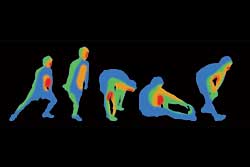
Surveillance Warm Up
Thermal imaging technology is sued to keep perimeter security in top shape
- By Tom Hoffman
- Jul 06, 2007
 THERMAL security cameras are imagers that see heat, or thermal energy, in an object. The human eye cannot detect thermal energy. This energy does not get to the retina because the eye’s lens and fluids absorb it. Thermal security cameras allow users to see what their eyes cannot—invisible heat radiation emitted by all objects regardless of lighting conditions. Thermal cameras form video pictures based on the small temperature differences between objects.
THERMAL security cameras are imagers that see heat, or thermal energy, in an object. The human eye cannot detect thermal energy. This energy does not get to the retina because the eye’s lens and fluids absorb it. Thermal security cameras allow users to see what their eyes cannot—invisible heat radiation emitted by all objects regardless of lighting conditions. Thermal cameras form video pictures based on the small temperature differences between objects.
Thermal cameras are extremely effective security tools in any environment. The technology can readily detect intruders and other potential hazards.
Although there are other technologies available that can help users see at night, thermal camera technology has some distinct advantages. To understand the differences between the technologies available, users need to understand how each operate, and the inherent advantages and disadvantages.
Lights
The most common way facilities cope with the darkness of night is to install many powerful lights that generate enough visible light energy for daylight—or even lowlight—cameras to work.
The lights and camera combination has a number of disadvantages. TNot only is this combination expensive, but there are many areas—like waterfronts and wetlands—where the two are not practical. Obviously, lights have uses, they are effective and efficient in small areas, and they act as a deterrent. Whether lights actually help security professionals see anything with a daylight cameras is, at best, debatable.
Reflected Versus Emitted Light Energy
Humans can see reflected light. This is the light energy hitting something and bouncing off it, then received by a detector that turns it into an image. Infrared illuminated cameras, night vision devices and the human eye all work on the same basic principle. Unfortunately, the ability of a given detector—be it in an eyeball or a camera—to create images relates directly to the amount of light available.
At night, there isn’t much visible light to work with, so users are limited to what is provided by star light, moon light and artificial lights. If there isn’t enough, you can’t see. A common limitation for reflected visible light receptors is contrast. Like the eye, cameras create better images if an object has more of contrast compared to its background. If it doesn’t, you won’t see it. In other words, it’s Camouflaged. Camouflage is essentially just a way of decreasing the visible contrast between an object and its surroundings.
Night Vision Goggles
Night vision technology, whether used in goggles or as a discrete camera, works essentially the same way as any other visible light imaging system. Receptors magnify small amounts of visible light thousands of times so objects become visible at night.
But night vision systems have the same weakness as a regular TV camera—the dependance on visible, reflected light. Similarly, too much light can overwhelm the system, causing “bloom” and reduced effectiveness. Because night vision technology needs a minimum amount of light to work, conditions, such as heavy overcast and light fog, can severely limit effectiveness.
Infrared Illuminated Cameras
Infrared illuminated cameras also are sensitive to reflected light energy, just like an eye. As with other visible light imaging systems, infrared illuminated cameras starve for light at night and can’t make a usable image without help. The technology compensates by transmitting energy that reflects off the objects within the camera’s view and using those reflections to make a picture. Unfortunately, even reasonably powered illuminators are weak, resulting in severe range limitations. The range of performance relies on the reflected light energy limited by the strength of the energy being reflected.
Moreover, infrared illuminated cameras are far from covert. Any intruder equipped with a handheld camera can see where infrared illuminators are pointing, and approach in non-illuminated areas.
Going Thermal
Thermal security cameras don’t suffer from the limitations of visible light imaging: light availability and contrast. First, thermal cameras don’t need reflected light energy. The technology sees heat given off by objects. Everything you see normally creates heat energy—day and night, in good and bad weather.
Not only do warm-blooded creatures produce their own thermal energy, but in doing so, create contrast. What’s more, energy seen by thermal security cameras generally creates a better image at night than during the day. The cameras work during the day. As long as there is the smallest amount of temperature contrast between a target and its background, you can see it, but the technology is designed to work best at night.
Thermal security cameras are the only solution available today providing an affordable alternative to visible light imaging. Thermal cameras work day or night, require no special lighting or infrastructure, are not range-limited by sunlight, and have better contrast than visible light cameras. The technology also is immune to almost all forms of camouflage. With the advantages, thermal security cameras are a solution to any nighttime imaging problem.